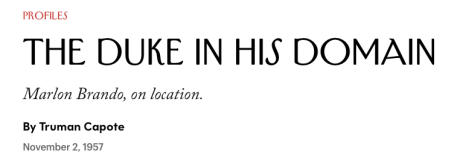From Truman Capote‘s “The Duke In His Domain,” published in The New Yorker on 11.2.57…excellent writing, phrased just so, based on a Marlon Brando interview in Kyoto’s Miyako hotel during location filming of Sayonara:
“The maid had reëntered the star’s room, and Murray, on his way out, almost tripped over the train of her kimono. She put down a bowl of ice and, with a glow, a giggle, an elation that made her little feet, hooflike in their split-toed white socks, lift and lower like a prancing pony’s, announced, ‘Appapie! Tonight on menu…appapie.’
“Brando groaned. ‘Apple pie….that’s all I need.” He stretched out on the floor and unbuckled his belt, which dug too deeply into the swell of his stomach. ‘I’m supposed to be on a diet. But the only things I want to eat are apple pie and stuff like that.’
“Six weeks earlier, in California, [director Joshua] Logan had told him he must trim off ten pounds for his role in Sayonara, and before arriving in Kyoto Brando had managed to get rid of seven. Since reaching Japan, however, abetted not only by American-type apple pie but by the Japanese cuisine, with its delicious emphasis on the sweetened, the starchy, the fried, he’d regained, then doubled this poundage.
“Now, loosening his belt still more and thoughtfully massaging his midriff, he scanned the menu, which offered, in English, a wide choice of Western-style dishes, and, after reminding himself ‘I’ve got to lose weight,’ ordered soup, beefsteak with French-fried potatoes, three supplementary vegetables, a side dish of spaghetti, rolls and butter, a bottle of sake, salad, and cheese and crackers.
“’And appapie, Marron?’
“He sighed. ‘With ice cream, honey.’

“Watching him now, with his eyes closed, his unlined face white under an overhead light, I felt as if the moment of my initial encounter with him were being recreated. The year of that meeting was 1947; it was a winter afternoon in New York, when I had occasion to attend a rehearsal of Tennessee Williams’ A Streetcar Named Desire, in which Brando was to play the role of Stanley Kowalski.
“It was this role that first brought him general recognition, although among the New York theatre’s cognoscenti he had already attracted attention, through his student work with the drama coach Stella Adler and a few Broadway appearances — one in a play by Maxwell Anderson, Truckline Café, and another as Marchbanks opposite Katharine Cornell’s Candida — in which he showed an ability that had been much praised and discussed.
“Ten years ago, on the remembered afternoon, Brando was still relatively unknown; at least, I hadn’t a clue to who he might be when, arriving too early at the Streetcar rehearsal, I found the auditorium deserted and a brawny young man stretched out atop a table on the stage under the gloomy glare of work lights, solidly asleep. Because he was wearing a white T-shirt and denim trousers, because of his squat gymnasium physique — the weight-lifter’s arms, the Charles Atlas chest (though an opened ‘Basic Writings of Sigmund Freud’ was resting on it) — I took him for a stagehand. Or did until I looked closely at his face.
“It was as if a stranger’s head had been attached to the brawny body, as in certain counterfeit photographs. For this face was so very untough, superimposing, as it did, an almost angelic refinement and gentleness upon hard-jawed good looks: taut skin, a broad, high forehead, wide apart eyes, an aquiline nose, full lips with a relaxed, sensual expression. Not the least suggestion of Williams’ unpoetic Kowalski.
“It was therefore rather an experience to observe, later that afternoon, with what chameleon ease Brando acquired the character’s cruel and gaudy colors, how superbly, like a guileful salamander, he slithered into the part, how his own persona evaporated — just as, in this Kyoto hotel room ten years afterward, my 1947 memory of Brando receded, disappeared into his 1957 self.
“The present Brando, the one lounging there on the tatami and lazily puffing filtered cigarettes as he talked and talked, was, of course, a different person — bound to be. His body was thicker; his forehead was higher, for his hair was thinner; he was richer (from the producers of Sayonara he could expect a salary of three hundred thousand dollars, plus a percentage of the picture’s earnings); and he’d become, as one journalist put it, ‘the Valentino of the bop generation’ — turned into such a world celebrity that when he went out in public here in Japan, he deemed it wise to hide his face not only by wearing dark glasses but by donning a surgeon’s gauze mask as well. (The latter bit of disguise is not so outré in Japan as it may sound, since numerous Asians wear such masks, on the theory that they prevent the spreading of germs.)
“Those were some of the alterations a decade had made. There were others. His eyes had changed. Although their caffè-espresso color was the same, the shyness, any traces of real vulnerability that they had formerly held, had left them; now he looked at people with assurance, and with what can only be called a pitying expression, as though he dwelt in spheres of enlightenment where they, to his regret, did not. Nevertheless, the subtly tender character of his face had been preserved. Or almost.”














